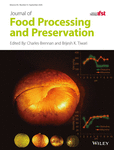Moringa oleifera defatted flour: Nutritive and bioactive impact of shells
Abstract
The worldwide demand for sustainable protein sources is increasing. Moringa oleifera seed cake has a promising potential, as large quantities are available after oil extraction. Previous research showed that shells have a positive impact on the oil bioactivity, with this work aiming to understand the impact of shells’ presence in defatted flours from a nutritional perspective. Shells decreased proteins (57.4 to40.6%), with a proportional variation in amino acids, both equally rich in essential amino acids. Fatty acids relative amounts were only slightly affected by the shells (C22:0 and C24:0; p ≤ .05), while total lipids doubled in kernel flours (1.2% vs. 2.3%). Unshelled flour was richer in crude fibers (2.7% vs. 11.9%), vitamin E (1.6 vs. 2.5 mg/kg), phenolic compounds (particularly catechin), and presented higher antioxidant capacity. Unshelled M. oleifera defatted flour represents a rich source of high-quality protein, higher than soybean cake, with an equilibrated nutritional profile, interesting for food fortification or supplementation purposes.
Practical applications
The utilization of oilseed residues is economically and ecologically attractive. These by-products are rich in protein and other bioactive components seek for the food industry. Our study compares M. oleifera seed flours (both whole seeds and kernels) as a new oilseed by-product for food enrichment,with potential outcomes as a new protein source rich in fibers and antioxidants.
CONFLICT OF INTEREST
The authors have declared no conflicts of interest for this article.




